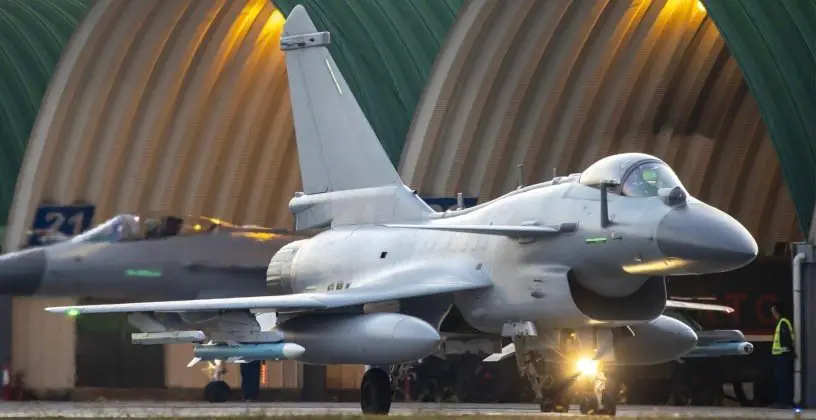<p >The Chinese People’s Liberation Army Air Force’s J-10C fighter has participated in complex training exercises, and&nbsp;demonstrated a range of advanced capabilities under&nbsp;realistic combat conditions. The fighters were employed in a range of scenarios, which included successive takeoffs by multiple J-10Cs, and manoeuvres that required very high levels of coordination. These exercises tested the pilots’ ability to deploy rapidly, engage in mid air, and integrate effectively with other units. The exercises are intended to increase interoperability among the various branches of the People’s Liberation Army, to improve the individual capabilities of pilots, and to enhance the collective capabilities of the unit involved – the name of which was not disclosed. The ability of Chinese fighter units to stage particularly complicated exercises is facilitated by the very high levels of flight training which pilots receive annually, which significantly exceeds hours allocated to fighter pilots in the U.S. Air Force, in the large majority of Western countries, or in Russia.&nbsp;&nbsp;</p><p ><img src=" title="J-10C Fighter"></p><p >The J-10C is one of three fighter classes that has been acquired by China’s air force over the past five years, alongside the <a href=" target="_blank">J-20 fifth generation fighter</a> and the&nbsp;<a href=" target="_blank">‘4+ generation’ J-16</a>. Where the other two are heavyweights, the J-10C is a lightweight fighter with a single engine and half the thrust of the J-16, and is restricted by its much smaller combat radar and shorter range. Despite the limitations of its size, the fighter is highly prized for its sophistication, and is widely considered to be overall the most capable class of single engine fighter in the world other than the American fifth generation F-35. China is one of just two countries to widely deploy indigenous fifth generation fighters, alongside the United States, with many of the technologies that were developed for the J-20 program having benefitted the development of the J-10C and J-16. The J-20’s development and continuous modernisation has been among the most important indicators of the world leading position which China’s fighter aviation industry has gained.</p><p ><img src=" title="J-16, J-10C and J-20 Fighters in the Late 2010s"></p><p >The J-10C has been acquired in very large numbers, with over 300 thought to be in service at the most conservative estimates, allowing multiple air units to rapidly be modernised to a cutting edge standard far more cheaply than would be possible if equipping them with the similarly advanced but much larger J-16, or with the J-20. The aircraft is not only much less costly to produce, but also has much lower operational costs and maintenance needs than its larger counterparts. </p><p >The J-10C’s production scale, estimated to be around 50 fighters per year, is by far the greatest of any fourth generation fighter class in the world, and is surpassed only by those of the J-20 and F-35. Domestic acquisitions of the fighter have notably slowed since 2021, both due to a <a href=" target="_blank">major surge</a> in J-20 production, and in order to allow a portion of productive capacity to be allocated to meeting <a href=" orders</a> for the fighters. Pakistan is expected to acquire 72 of the aircraft. The J-10C has continued to gain significant interest from a range of foreign clients, with some of the most interested parties reported to include Azerbaijan, Iran, Egypt and Sudan.&nbsp;</p><p ><img src=" title="Pakistan Air Force J-10C with External Fuel Tanks and PL-15 Missiles"></p><p >Despite its small size, the J-10C has proven capable of outperforming much larger fighters in air to air combat, with the aircraft reported in 2020 to have <a href=" >consistently outperformed</a> the Russian Su-35&nbsp;in simulated engagements. The fighter class has also at times <a href=" target="_blank">outperformed the J-16</a> in such engagements, albeit far less consistently, with the two considered well matched if the J-10C is able to compensate for its weaker sensors by sharing data with supporting assets. A notable advantage the fighter retains over the vast majority of foreign rivals is its integration of the PL-10 air to air missile, which is designed for visual range engagements and can engage targets at far more extreme angles away from the fighter’s nose than almost all rival missile classes. The fighter’s PL-15 was also considered the most capable beyond visual range air to air missile class in the world when it entered service around 2015, although it has since faced a serious challenge from the American AIM-260 which was developed specifically to restore an American advantage in the field.&nbsp;</p>
Chinese J-10C Fighters Complete Complex Multi-Service Exercises: What Makes Them So Dangerous?

